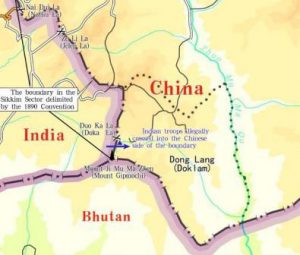“Tibet is now in its golden age ” – White Paper on Tibet Autonomous Region

BEIJING (Xinhua) — China issued a white paper on Tibet, reaffirming the current regional ethnic autonomous policy ahead of the 50th anniversary of the foundation of Tibet Autonomous Region.
The Tibet Autonomous Region was founded on Sept. 1, 1965, after the establishment of the regional People’s Congress, the local legislature, through elections.
Titled “Successful Practice of Regional Ethnic Autonomy in Tibet,” the white paper said since the democratic reform was carried out in 1959 and regional ethnic autonomy came into practice in 1965, Tibet has established the new socialist system and achieved historic leaps and bounds in its economic and social development.
Practice has fully demonstrated that regional ethnic autonomy is a requirement for Tibet’s development and progress, and conforms to the fundamental interests of all ethnic groups in Tibet.
Tibet has taken a road that unites it with all China’s ethnic groups and struggles to develop equally, achieve prosperity, and make progress with them, it added.
Tibet’s traditional culture is well protected and promoted, and freedom of religious belief in the Region is respected and protected, while its ecological environment is protected, too, the white paper added.
As part of the Chinese nation, the Tibetan people fulfill the right to participate equally in the management of state affairs; they are thus managers of local social affairs and masters of their own destiny, creating and sharing the material and spiritual wealth of Tibet.
“Tibet is now in its golden age,” the paper said.
Religions in Tibet
Tibet have fully respected citizens’ rights on freedom of religious belief, and given equal attention and protection to all religions and sects, white paper said.
Religious activities are respected and protected. Currently, there are 1,787 sites for different religious activities in Tibet, and more than 46,000 resident monks and nuns, the white paper titled Successful Practice of Regional Ethnic Autonomy in Tibet said.
In Tibet Autonomous Region, religious festivals are celebrated in the same way as they always were. More than 40 major religious activities, such as pilgrimages to holy mountains and lakes, the Saga Dawa Festival, the Buddha Exhibition Festival, and the Lamaist Devil Dance Festival, are protected and inherited, said the paper.
Temples are maintained and protected. Since the 1980s, the state has allocated funds, gold, and silver to maintain, renovate and protect temples. More than 1.4 billion yuan has been spent on restoring Tibetan cultural relics and refurbishment of key monasteries, it said.
A total of 6.7 million yuan, 111 kg of gold, 2,000 kg of silver, and a large amount of jewelry have been used to renovate stupas and prayer halls from the Fifth Panchen Erdeni to the Ninth Panchen Erdeni. The state budget to build those for the 10th Panchen Erdeni was 66.2 million yuan and 650 kg of gold, it added.
The Living Buddha reincarnation is proceeding well. Through traditional religious rituals and historical conventions like drawing lots from a golden urn, and with the approval of the State Council, the Tibet Autonomous Region sought out and identified the reincarnation of the 10th Panchen Erdeni, and conferred and enthroned the 11th Panchen Erdeni in 1995, according to the paper.
Tibet now has 358 Living Buddhas, more than 60 of whom have been confirmed through historical conventions and traditional religious rituals, it added.
The paper said over the years, the 14th Dalai Lama clique, in plotting towards “Tibetan independence,” has constantly preached the “middle way,” peddled the concept of a “Greater Tibet,” and lobbied for “a high degree of autonomy,” so negating regional ethnic autonomy and its contribution to Tibet’s progress.
“The 14th Dalai group’s separatist activities violate the Constitution of China and its state system, and greatly damage the fundamental interests of all ethnic groups in Tibet, which is why they have met strong opposition from all Chinese people, including those of all ethnic groups in Tibet, and hence why they are doomed to fail,” the white paper said.
Old Tibet was dark and backward as even in the 1950s, it was still a society ruled by feudal serfdom under theocracy, according to a white paper .Having existed for several centuries, this wretched system stifled human rights and destroyed human qualities.
Implementing the system of regional ethnic autonomy in Tibet conforms to China’s reality as a unified multi-ethnic country.Ever since ancient times, Tibet has been an integral part of China, and the Tibetan ethnic group has been a communal member of the Chinese nation sharing a common destiny, the white paper said.
From 1952 to 2014, China’s central government provided Tibet with financial subsidies totaling 648.08 billion yuan, a white paper on Tibet said.The amount accounted for 92.8 percent of Tibet’s public financial expenditure.
Tibet’s GDP increased by 281 times
Tibet’s GDP soared from 327 million yuan in 1965 to 92.08 billion yuan (14.5 bln U.S. dollars) in 2014, a 281-fold increase, a government white paper said.
It showed that under the system of regional ethnic autonomy, Tibet’s economic and social development has achieved leapfrog development by constantly reaching higher levels
Tibet Autonomous Region has done much and made remarkable achievements towards respecting, protecting, inheriting, and carrying forward Tibet’s excellent traditional culture, according to a government white paper issued on Sept. 6, 2015.














